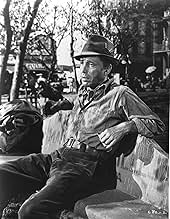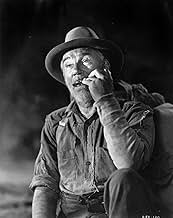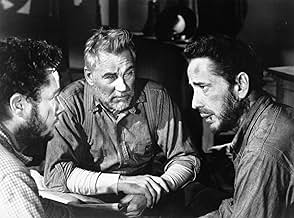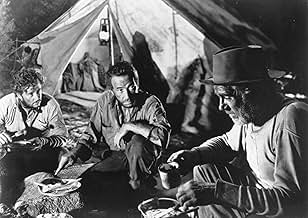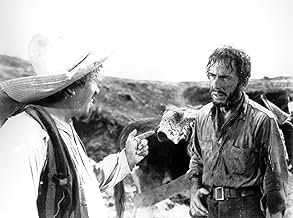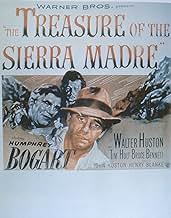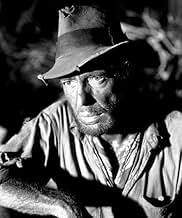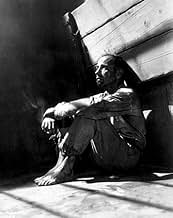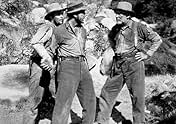Messico. Fred, senza soldi e senza lavoro conosce un vecchio cercatore d'oro e, affascinato dai suoi racconti, lo convince a partire per la Sierra Madre. A loro si unisce un altro giovane co... Leggi tuttoMessico. Fred, senza soldi e senza lavoro conosce un vecchio cercatore d'oro e, affascinato dai suoi racconti, lo convince a partire per la Sierra Madre. A loro si unisce un altro giovane compagno. I tre riescono a trovare l'oro; ma l'avidità li renderà spietati.Messico. Fred, senza soldi e senza lavoro conosce un vecchio cercatore d'oro e, affascinato dai suoi racconti, lo convince a partire per la Sierra Madre. A loro si unisce un altro giovane compagno. I tre riescono a trovare l'oro; ma l'avidità li renderà spietati.
- Regia
- Sceneggiatura
- Star
- Vincitore di 3 Oscar
- 18 vittorie e 5 candidature totali
Barton MacLane
- Pat McCormick
- (as Barton Mac Lane)
Arturo Soto Rangel
- Presidente
- (as A. Soto Rangel)
Manuel Dondé
- El Jefe
- (as Manuel Donde)
José Torvay
- Pablo
- (as Jose Torvay)
Robert Blake
- Mexican Boy Selling Lottery Tickets
- (non citato nei titoli originali)
Guillermo Calles
- Mexican Storeowner
- (non citato nei titoli originali)
Roberto Cañedo
- Mexican Lieutenant
- (non citato nei titoli originali)
Spencer Chan
- Proprietor
- (non citato nei titoli originali)
Jacqueline Dalya
- Flashy Girl
- (non citato nei titoli originali)
Ralph Dunn
- Flophouse Bum
- (non citato nei titoli originali)
Ernesto Escoto
- Mexican Bandit
- (non citato nei titoli originali)
Pat Flaherty
- Customer in Bar Who Warns Curtin and Dobbs about Pat McCormick
- (non citato nei titoli originali)
Riepilogo
Reviewers say 'The Treasure of the Sierra Madre' is a critically acclaimed classic, lauded for its profound examination of greed, betrayal, and human nature. John Huston's direction and screenplay, alongside exceptional performances by Humphrey Bogart, Walter Huston, and Tim Holt, are often celebrated. The film's authentic atmosphere, intricate character studies, and moral complexities deeply resonate. Although some critique its pacing and subplots, most regard it as a timeless masterpiece noted for its psychological depth and thematic richness.
Recensioni in evidenza
Having had his day as an idolized star and romantic leading man, it was now time for Bogart to get down to the serious business of acting
For eighteen years it had usually been Bogart playing Bogart in various shadings
Now that Bogart was gone and in his place was an older and far less romantic figure, one who found new challenges and was able to meet most of them successfully
This new phase of his continued growth began with a story of three men in search of gold
Although "The Treasure of the Sierra Madre" is indisputably one of Bogart's best films, it was co-star Walter Huston who won an Academy Award as did the movie's director and scenarist, John Huston
Based on a novel by the mysterious B. Traven, the film told a riveting tale which explored the degenerative effects of encroaching greed, distrust, and hatred on three prospectors who team up to search for gold in Mexico
Bogart's Fred C. Dobbs was an amazingly complex creation whose slow disintegration into paranoia was brilliant1y managed on camera He is a born loser with no potential for change in sight Suspicious, unfeeling, savage, and easily corruptible, he seems clearly destined for a tragic fate almost from our first meeting with him
Tim Holt was also excellent as Bob Curtin, a man who, like Bogart, is tempted but whose conscience will not permit him to exercise his baser desires. (He could have let Bogart die in a cave-in, but saved him instead.) Young, impressionable, and unprepared, he has never seen the likes of a Fred C. Dobbs and he finds himself overwhelmed and uncertain as to how he will cope with Dobbs's rage and greed
However, it is the director's father, Walter Huston, who literally stole the picture from both Bogart and Holt as he played Howard, a wise old toothless codger who knew all along what would happen and took it all in stride, kicking up his heels and having a marvelous time Life can't surprise him any more He's already had successes and failures enough for one lifetime Like a faithful dog, he's along for the thrill of the hunt, and should there be another pot of gold at the end of this rainbow, well, that's just a bonus
It is mainly the interaction of these three men from their first meeting and uneasy partnership through their final confrontation that made "The Treasure of the Sierra Madre" one of Warner Brothers' triumphs of the forties
Although "The Treasure of the Sierra Madre" is indisputably one of Bogart's best films, it was co-star Walter Huston who won an Academy Award as did the movie's director and scenarist, John Huston
Based on a novel by the mysterious B. Traven, the film told a riveting tale which explored the degenerative effects of encroaching greed, distrust, and hatred on three prospectors who team up to search for gold in Mexico
Bogart's Fred C. Dobbs was an amazingly complex creation whose slow disintegration into paranoia was brilliant1y managed on camera He is a born loser with no potential for change in sight Suspicious, unfeeling, savage, and easily corruptible, he seems clearly destined for a tragic fate almost from our first meeting with him
Tim Holt was also excellent as Bob Curtin, a man who, like Bogart, is tempted but whose conscience will not permit him to exercise his baser desires. (He could have let Bogart die in a cave-in, but saved him instead.) Young, impressionable, and unprepared, he has never seen the likes of a Fred C. Dobbs and he finds himself overwhelmed and uncertain as to how he will cope with Dobbs's rage and greed
However, it is the director's father, Walter Huston, who literally stole the picture from both Bogart and Holt as he played Howard, a wise old toothless codger who knew all along what would happen and took it all in stride, kicking up his heels and having a marvelous time Life can't surprise him any more He's already had successes and failures enough for one lifetime Like a faithful dog, he's along for the thrill of the hunt, and should there be another pot of gold at the end of this rainbow, well, that's just a bonus
It is mainly the interaction of these three men from their first meeting and uneasy partnership through their final confrontation that made "The Treasure of the Sierra Madre" one of Warner Brothers' triumphs of the forties
This film is a sharp-edged study of the effects of greed on otherwise normal men, and one man in particular: Bogart's Fred C. Dobbs. Dobbs and Bob Curtin (Tim Holt) are down and out and meet up with prospector Howard (Walter Huston). When Dobbs wins a lottery, he uses the proceeds to finance a trip for the three to central Mexico to search for gold.
The three have to deal with the lawlessness of central Mexico at the time - bandits were actually on the loose in that country killing anybody with stuff, and taking that stuff. The Federales were a violent solution to a violent problem - killing the bandits after a summary judgement and the bandits having dug their own graves. So our trio not only have to worry about bandits once they strike gold, they have to worry about the darkness of their own souls.
In the beginning, Bogart's Fred C. Dobbs is a decent guy who does not take advantage of others. Dobbs only takes his money from the guy that wouldn't pay and he does share his lottery ticket and is generous with his fellow miners, but as greed begins to take root in him, little by little we see his goodness eaten away. It's a great credit to the writing and Bogart's skills that this is done gradually and played out over time. Incidentally, that's director John Huston "staking him to a meal". One of the best director cameos ever (although Polanski in Chinatown is equally great)!
Dobbs overestimates himself and the fallibility of human nature. Walter Hustons character freely admits what gold could do to any of them including himself. Dobbs is sure it will never happen to him, but he's never had anything, so he's never faced temptation, and when he falls it's a long way down.
This may be Tim Holt's finest performance - it was probably his finest opportunity given he had spent years laboring as a B western star on the RKO lot. Walter Huston as the prospector, minus his dentures and plus a bunch of pounds and with holes in his clothes is not the debonair fellow you are used to seeing in film . If Mary Astor's character in Dodsworth could have thought this was the future appearance of the man she loved, would she have taken her gondola in the other direction? I guess we'll never know.
Highly recommended as one of the great character studies in which several characters get studied in detail.
The three have to deal with the lawlessness of central Mexico at the time - bandits were actually on the loose in that country killing anybody with stuff, and taking that stuff. The Federales were a violent solution to a violent problem - killing the bandits after a summary judgement and the bandits having dug their own graves. So our trio not only have to worry about bandits once they strike gold, they have to worry about the darkness of their own souls.
In the beginning, Bogart's Fred C. Dobbs is a decent guy who does not take advantage of others. Dobbs only takes his money from the guy that wouldn't pay and he does share his lottery ticket and is generous with his fellow miners, but as greed begins to take root in him, little by little we see his goodness eaten away. It's a great credit to the writing and Bogart's skills that this is done gradually and played out over time. Incidentally, that's director John Huston "staking him to a meal". One of the best director cameos ever (although Polanski in Chinatown is equally great)!
Dobbs overestimates himself and the fallibility of human nature. Walter Hustons character freely admits what gold could do to any of them including himself. Dobbs is sure it will never happen to him, but he's never had anything, so he's never faced temptation, and when he falls it's a long way down.
This may be Tim Holt's finest performance - it was probably his finest opportunity given he had spent years laboring as a B western star on the RKO lot. Walter Huston as the prospector, minus his dentures and plus a bunch of pounds and with holes in his clothes is not the debonair fellow you are used to seeing in film . If Mary Astor's character in Dodsworth could have thought this was the future appearance of the man she loved, would she have taken her gondola in the other direction? I guess we'll never know.
Highly recommended as one of the great character studies in which several characters get studied in detail.
The Treasure of the Sierra Madre (1948)
This is a weirdly contemporary film. I mean, it's certainly set in the past, and it's made in the heyday of Hollywood genius top to bottom which is long gone. But because it's about this old time and about raw black and white issues (often), the film and the filming are really appropriate. The whole thing just fits, and beautifully.
And I mean beautiful. As rugged as it all is--the landscape as well as the beards, all very real--the movie is lyrically filmed. The story is told with visual clarity. And the script, speaking of story, is sophisticated and believable. In all, under the direction of legend John Huston, this is a spot on terrific movie.
Of course, there are two actors who are just amazing in their roles (and a third, Tim Holt, who is just fine, if not stellar). I mean of course Walter Huston, who nearly steals the show in every scene. He's a character, but not a caricature. His wisdom--real wisdom, based on smart observation over decades of experience--is sterling. Great stuff, well put. And of course he's the father of the director, which is a fun, and slightly Freudian twist. He gives one of the great performances of the decade.
Humphrey Bogart is not far behind, actually. If you like him in Maltese Falcon or Casablanca, you'll be surprised at first by the scruffy, raw character played here. But it's clear-headed, brilliantly delivered Bogart all the way, and a joy to watch him really act. See it for him, too.
Then there is the story itself, which is as important now as ever. That is, what matters in life? And what is the price to pay to get it? It's all rather bold and emotional even though it's delivered by some rough guys out of money prospecting in the wilderness of Mexico.
Are there downsides here? I suppose. You certainly can wonder about the way the Mexicans--good ones and banditos both--are portrayed. I think it's not bad, tinged with clichés, of course, but in Spanish without translation or stilted half-English, so it's the real thing. And no subtitles. Nicely done for an early Hollywood affair. Huston, the son, the director, if you don't know, is famous for doing things raw and right and slightly off the charts. He is making a commercial film, to be sure, but it has many small aspects that are just not pandering to anyone. This makes it work.
I'm sure to some this is a masterpiece. I'm giving that some thought. See it.
This is a weirdly contemporary film. I mean, it's certainly set in the past, and it's made in the heyday of Hollywood genius top to bottom which is long gone. But because it's about this old time and about raw black and white issues (often), the film and the filming are really appropriate. The whole thing just fits, and beautifully.
And I mean beautiful. As rugged as it all is--the landscape as well as the beards, all very real--the movie is lyrically filmed. The story is told with visual clarity. And the script, speaking of story, is sophisticated and believable. In all, under the direction of legend John Huston, this is a spot on terrific movie.
Of course, there are two actors who are just amazing in their roles (and a third, Tim Holt, who is just fine, if not stellar). I mean of course Walter Huston, who nearly steals the show in every scene. He's a character, but not a caricature. His wisdom--real wisdom, based on smart observation over decades of experience--is sterling. Great stuff, well put. And of course he's the father of the director, which is a fun, and slightly Freudian twist. He gives one of the great performances of the decade.
Humphrey Bogart is not far behind, actually. If you like him in Maltese Falcon or Casablanca, you'll be surprised at first by the scruffy, raw character played here. But it's clear-headed, brilliantly delivered Bogart all the way, and a joy to watch him really act. See it for him, too.
Then there is the story itself, which is as important now as ever. That is, what matters in life? And what is the price to pay to get it? It's all rather bold and emotional even though it's delivered by some rough guys out of money prospecting in the wilderness of Mexico.
Are there downsides here? I suppose. You certainly can wonder about the way the Mexicans--good ones and banditos both--are portrayed. I think it's not bad, tinged with clichés, of course, but in Spanish without translation or stilted half-English, so it's the real thing. And no subtitles. Nicely done for an early Hollywood affair. Huston, the son, the director, if you don't know, is famous for doing things raw and right and slightly off the charts. He is making a commercial film, to be sure, but it has many small aspects that are just not pandering to anyone. This makes it work.
I'm sure to some this is a masterpiece. I'm giving that some thought. See it.
Some movies have certain scenes in them that hold the viewers interest more than others. However every single scene in this film holds the viewers interest. There is never a dull or lagging moment. Three down and outers who at one time in their lives were maybe up and comers strike out in search of a fortune or at least enough to live better than they have been.
While Humphrey Bogart gives a superb performance it is Walter Huston who turns in the greatest performance as the old prospector Howard. The scene in the Indian village where he helps to restore a comatose child is one of the most touching in all of film history and is done virtually without any dialog. Mexican character actor Alfonso Bedoya of course steals all the scenes he appears in and delivers his classic "Stinking Badges" line. (what person would dress up as a Bandito for a costume party and not want to look exactly like Bedoya's Gold Hat character?) This film probably should have been a little higher on AFI's top 100. A must see!
While Humphrey Bogart gives a superb performance it is Walter Huston who turns in the greatest performance as the old prospector Howard. The scene in the Indian village where he helps to restore a comatose child is one of the most touching in all of film history and is done virtually without any dialog. Mexican character actor Alfonso Bedoya of course steals all the scenes he appears in and delivers his classic "Stinking Badges" line. (what person would dress up as a Bandito for a costume party and not want to look exactly like Bedoya's Gold Hat character?) This film probably should have been a little higher on AFI's top 100. A must see!
In the 1920's, labor was hard to find. If you happened to be a laborer, work was almost non existent. Indeed, if you were unemployed and in Mexico, your chances were dismal. Yet, these were the times, which attracted many South of the border. The place was barren, yet many a fortune could spring up directly before you, . . .if you were luckily enough to see it. That is the story behind this incredible film. The legend of El Dorado was only one of the many myths which lured the adventurous to Mexico, another was "The Treasure of the Sierra Madre." The gold of the Mother of Mountains was passed from father to son for generations. Thus when the film adaption was made, it was sure to be sculpted by men of vision. One such man is legendary John Huston who directed this film. Three common men are lured by the promise of discovering a lost treasure. The first is Fred C. Dobbs (Humphrey Bogart) a nice enough guy who wants only to be fair, but is hungry to 'strike it rich.' The second is Howard, (Walter Huston) as honest as you expect him to be and a man of considerable experience. The last is Bob Curtin (Tim Holt) who if given a chance, will use it. The trio make a PAC to share and share alike all the treasure they find. However, only Howard is aware of what the possession of Gold can do to a man. To find the treasure, they need the mountain, some hard work, a little luck. To bring it home, will require something only one of them possesses. The film is a Classic and is due to the combined talents of all the stars and the director. If you look closely, you'll see Robert Blake (Barreta) and John Huston in brief roles. ****
Lo sapevi?
- QuizJohn Huston stated that working with his father on this picture and his dad's subsequent Oscar win were among the favorite moments of his life.
- BlooperAlthough set in the 1920s, many of the cars on the streets of Tampico are of 1930s and 1940s vintage; likewise, women, when prominently seen, are groomed and dressed strictly in the style of the 1940s.
- ConnessioniFeatured in The Screen Writer (1950)
- Colonne sonoreBelieve Me If All Those Endearing Young Charms
(1808) (uncredited)
Music traditional
Played on harmonica by Walter Huston
I più visti
Accedi per valutare e creare un elenco di titoli salvati per ottenere consigli personalizzati
Dettagli
- Data di uscita
- Paese di origine
- Lingue
- Celebre anche come
- El tesoro de la Sierra Madre
- Luoghi delle riprese
- Kernville, California, Stati Uniti(Kelly's Rainbow Mine)
- Azienda produttrice
- Vedi altri crediti dell’azienda su IMDbPro
Botteghino
- Budget
- 3.000.000 USD (previsto)
- Lordo Stati Uniti e Canada
- 5.014.000 USD
- Fine settimana di apertura Stati Uniti e Canada
- 144.074 USD
- 14 gen 2018
- Lordo in tutto il mondo
- 5.014.000 USD
- Tempo di esecuzione2 ore 6 minuti
- Colore
- Proporzioni
- 1.37 : 1
Contribuisci a questa pagina
Suggerisci una modifica o aggiungi i contenuti mancanti

Divario superiore
What was the official certification given to Il tesoro della Sierra Madre (1948) in Japan?
Rispondi

